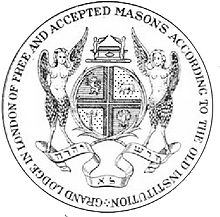Get Today in Masonic History into your Inbox. Sign up today for one of our email lists!
Need an article for your Trestleboard/Newsletter see our Use Policy
Ancients v. Moderns

Today in Masonic History we discuss Ancients v. Moderns.
The issue of the Ancients v. Moderns is an important part of Masonic history.
In 1717 the Grand Lodge of England formed with four speculative lodges in London. As the Grand Lodge grew and more lodges considered joining, a new concept in Freemasonry at the time, a divide began to form. The divide largely revolved around the ritual used in conducting masonic ceremonies. The group which eventually became the Moderns felt the ritual work should be modernized and should be less emphasized in the fraternity. In opposition, the Ancients (some times Antient) felt the original ritual should be adhered to, often pointing out straying from ancient ritual was straying from the landmarks of Freemasonry.
Essentially the split was about whether Freemasonry needed to become more of a social club or a fraternal organization rooted in the operative lodges.
In 1751, the rift between the Ancients and the Moderns came to a head and the two Grand Lodges were formed. The Moderns retained control of the Grand Lodge of England, the Ancients established the Most Ancient and Honourable Society of Free and Accepted Masons according to the Old Constitutions. The perceived leader of the Ancients was Laurence Dermott, who was never the Grand Master of the Ancient Grand Lodge, he was it's Secretary and Deputy Grand Master at various times through the rest of his life.
Dermott wrote the first Ahiman Rhezon, the book of constitutions for the Ancient Grand Lodge and to this day is the name of the Book of Constitutions for a variety of Grand Lodges around the World who were associated with the Ancients. Initially, Dermott wrote the Constitutions merely for it's natural purpose of governing the new Ancient Grand Lodge, in later versions he began adding attacks against the Moderns, often with sarcastic tones in his writings.
Around 1764, a lodge in Edinburgh which affiliated with the Ancient Grand Lodge, moved their charter to the Moderns. The lodge was instrumental in creating the Grand Chapter of Royal Arch Masonry. This was somewhat ironic since the Moderns did not recognize Royal Arch masonry as legitimate Freemasonry.
One of the members of the Edinburgh Lodge was William Preston who became an important lecturer on Freemasonry. He also became the Assistant Grand Secretary of the Modern Grand Lodge. In this position he began a correspondence with the Grand Lodge of Scotland attempting to convince them to sever ties with the Ancients. This caused greater strife within the Modern lodges.
Preston eventually joined Antiquity Lodge in London and become it's Worshipful Master. There a split between Antiquity and the Modern Grand Lodge began. Preston, along with several other members of the lodge walked to church one morning in full regalia. Enemies of Preston sent word to to the Modern Grand Lodge calling it an unauthorized parade. Preston fought with the Modern Grand Lodge and was eventually expelled. The brothers of Antiquity Lodge, expelled the three brothers who contacted the Modern Grand Lodge and then a large group of them left the Moderns with Preston. They affiliated themselves with the Grand Lodge of All England at York, which was not a governing body the same way other Grand Lodges were. They were an individual independent lodge. The members of Antiquity Lodge who left formed the Grand Lodge of All England South of the River Trent.
By 1791, the Moderns started to move back toward the Ancient ritual. There is speculation as to what actually caused the two grand lodges to begin to reconcile. One theory is Laurence Dermott passed away in 1791 and as one of the more outspoken individuals against the Moderns it became easier for the conversations to occur. Another event having an effect was the Unlawful Societies Act which was passed to go after spies working for Napoleon. According to the act a person could not belong to an organization with secret oaths. This affected both the Ancients and the Moderns. It forced them in 1799 to work together to prevent Freemasonry from being outlawed. Thanks to their efforts and the efforts of the Grand Lodge of Scotland an exception for Masonic Lodges was added to the act.
The two Grand Lodges came together to form the United Grand Lodge of England on December 27th, 1813 which is the Feast of St. John the Evangelist.
This article provided by Brother Eric C. Steele.

